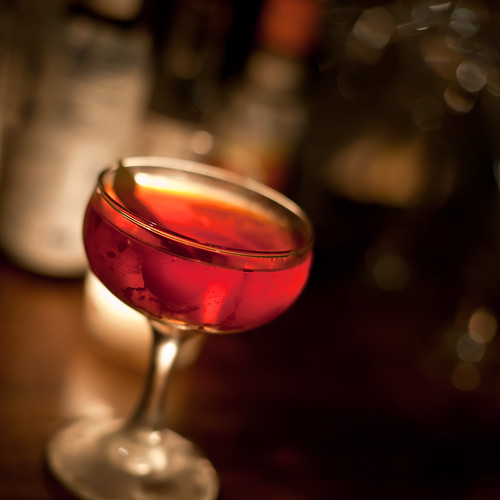Consider the Negroni … the perfect cocktail?
[NOTE: This is a preview post highlighting an upcoming seminar at the 2011 Tales of the Cocktail in New Orleans, taking place July 20-24, and is is crossposted from the original post at Talesblog.com. It fits in rather well with my Negroni variation series posted here, here, here and here.]
Do you remember your first Negroni?
I do. It was way back in the early days of my cocktail journey, when I was a mere cocktail toddler. One of the many silly things I thought I “knew” then was that I hated Campari, the frighteningly red (colored with bugs, eww!) and bitter (gaah!) potion that I had heard Italians drank with soda. I tried a Campari and soda at the time and … it didn’t speak to me. (That was primarily because I wasn’t listening, and my palate still had some maturing to do.) Then someone made me a Negroni. I was hesitant — I don’t like Campari! — but I was assured, “You’re going to like this a lot more than Campari and soda. Trust me.” I don’t even remember who the bartender was, but I owe him my thanks. The Negroni is one of my very favorite cocktails, and we go through so much Campari at home now that I ought to start buying it by the case. I’m even enjoying cocktails (nay, especially enjoying cocktails) in which Campari is actually the base spirit.
It’s such a marvelous combination of ingredients — the bracing bite of the Campari, the aromatic and spiritous backbone of the gin, the sweetness and spice of the vermouth — that it lends itself to lots of tinkering. Some bartenders have made them with genever instead of gin, different styles of gin and bitters, or even a powerfully funky rum, and I’ve become a huge fan of its Bourbon-bearing cousin. As much as I enjoy those drinks, we keep going back to the original time after time. Before dinner, a Negroni just hits the spot, and is one of our primary preprandial quaffs.
If you share a similar love and fascination with the Negroni, Paul Clarke has a seminar for you. He’ll be moderating “The Negroni: An Iconic Cocktail” at Tales of the Cocktail next month, and this is one you’re not going to want to mix. I asked Paul why a whole seminar about this cocktail, and what tantalizing tidbits he could share with us with five weeks left to go.
“In thinking about this session, I’ve come to the conclusion that not only is the Negroni an excellent cocktail — it’s perhaps the PERFECT cocktail,” he said. “It balances potency, sweetness and bitterness with an elaborate flavor that can be consistently engaging and always open to interpretation and inspiring creativity.” Indeed — see the interpretations and inspirations above!
Paul will be joined by some distinguished panelists as well. “One of my panelists is Livio Lauro, a bartender originally from Florence who is now head of U.S. Bartenders Guild in Las Vegas, and who just completed a translation of Luca Picchi’s book about Count Negroni and the development of the Negroni cocktail; the history and background of the drink is his department. I will be talking about the cultural context of the Negroni and how it’s a ‘bridge-the-gap’ drink between not only the 19th century simplicity drinks and the turn-of-the-century vermouth/bitter drinks, but also between the European aperitif tradition and the American cocktail tradition. My other panelist, Jacques Bezuidenhout, is of course a San Francisco-based bartender and consultant and a bonafide Negroni fiend; he’s going to talk a bit about the Negroni’s enduring legacy, and how it’s a foundation drink for so much creativity and inspiration behind the bar.”
I tried to pry a bit more from Paul about what we’ll actually be tasting during the seminar, but that proved to be a bit more difficult. “We’re going to be serving a few variations on the Negroni theme, all using identical ingredients and proportions, with minor tweaks to demonstrate how what’s basically the same drink can appeal in several different guises. I’ll keep the precise details close to the chest, but expect a couple of interesting takes on the Negroni — including one that most people have never before tried, and that for the first time is available for a large audience.” I have a suspicion as to what the latter reference refers, but I’ll keep that close to the chest as well. If I’m right, you’re in for a major treat.
Paul, Livio and Jacques will be presenting “The Negroni: An Iconic Cocktail” on Thursday, July 21 at 12:30pm. Buy your tickets now before this one sells out.







